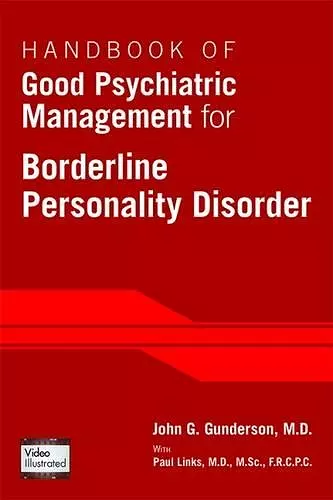Handbook of Good Psychiatric Management for Borderline Personality Disorder
John G Gunderson author Paul S Links author
Format:Paperback
Publisher:American Psychiatric Association Publishing
Published:16th Mar '14
Should be back in stock very soon

This book shows how practitioners can apply evidence-based principles to the management of patients with BPD without having to refer patients to more specialized but less accessible clinics. It is a practical guide to real-world therapy. Joel Paris, M.D., Professor of Psychiatry, McGill University The handbook is a basic training manual in case management of Borderline Personality Disorder (BPD) and how to become confident in dealing with these patients. The premise of the book is to have all psychiatrists become 'good enough' to treat these patients first-hand. The authors have done an amazing job of packing together rich information regarding how to handle everyday challenges and solve dilemmas by making solid decisions. The handbook is a clear advantage beyond all other teaching material prepared so far of how to manage borderline patients. It represents a treasure trove of readily usable knowledge and it offers the reader immediately useful therapeutic tools for decisions. It is a handbook full of insight by two frontier researchers and clinicians in borderline personality disorders. Their wealth of clinical wisdom will empower the reader and case manager. I recommend this book to all psychiatric residents, the psychiatric staff in psychiatric departments, psychiatrist in private practice and to general practitioners, whose aim is to handle these patients in a professional way and to feel comfortable doing so. Erik Simonsen, M.D., Ph.D., Professor of Psychiatry, Roskilde University & Institute of Personality Theory and Psychopathology; Director, Unit of Psychiatric Research, Region Zealand, Denmark Overall, I find this Handbook to be extremely important and to fill an important gap in the literature on BPD. It provides a fairly straightforward guideline for treating BPD that is available to the typical mental health professional. That is a huge contribution. The evidence-based treatments can at times be intimidatingly prescriptive and require expensive, intensive training. This leaves the bulk of clinicians who do not have the time and money to get that training and yet have to take care of people with BPD (as it is so common) with a sense of uncertainty and inadequacy. The present Handbook helps clinicians build on their basic skill set to become empowered to treat this sometimes difficult group of patients. I therefore find it to be a major contribution that we need desperately in our field. Antonia S. New, M.D., Prof, Psych & Dir, Med Student Educ, Dept of Psych, Icahn Scl of Med at Mount Sinai; Co-Dir, Clin & Translational Research, Mntl Illness Research & Educ Ctr, James J Peters VAMC
This book is a guide to using the evidence-based Good Psychiatric Management (GPM) approach for the treatment of BPD. The book demystifies the disorder, supplying treatment guidelines, case studies, and online video demonstrations of core techniques needed to deliver effective short-term, intermittent, and non-intensive therapeutic care.
The diagnosis and treatment of patients with BPD can be fraught with anxiety, uncertainty, and complexity. How welcome, then, is the Handbook of Good Psychiatric Management for Borderline Personality Disorder, which teaches clinicians what to do and how to do it, as well as what not to do and how to avoid it. The author, a renowned researcher and clinician, has developed a new evidence-based treatment, Good Psychiatric Management (GPM) that comfortably utilizes cognitive, behavioral, and psychodynamic interventions that are practical and simple to implement. Because psychoeducation is an important component of GPM, the book teaches clinicians how to educate their patients about BPD, including the role of genetics and the expected course of the disease. This approach offers advantages both to practitioners, who become more adept at honest communication, and to patients, who are encouraged to have realistic hopes and to focus on strategies for coping with BPD in daily life.
The book is structured for maximum learning, convenience, and utility, with an impressive array of features.
• Section I provides background on BPD, including the myths that sometimes discourage clinicians from treating these patients and that hamper the effective treatment of the disorder.
• Section II, the GPM Manual, provides a condensed and clear description of the most essential and specific GPM interventions that clinicians can learn from and use in everyday practice.
• Section III, the GPM Workbook, offers case vignettes which reference chapters from the manual. Each vignette has a number of "decision points" where alternative interventions are proposed and discussed.
• To further facilitate learning, a set of nine interactions is found in a series of online video demonstrations. Here, readers can see in vivo illustrations of the GPM model in practice.
• Finally, a set of appendices provides critical information, such as a comparison of GPM with other evidence-based treatments of BPD, scaling risk and response strategies, and family guidelines.
Designed to be a basic case management text for all...
This is an excellent book for treating patients with BPD. There are too many useful features to enumerate, but what I found most interesting is the data that most BPD patients get better with "good enough" treatment and do not need to be managed through high-level tertiary care centers. This book provides clinicians with the guidelines and the confidence to treat borderline patients, including those who have not had training or supervision related to this problem. Of particular importance is that Dr. Gunderson's approach is flexible and pragmatic, in recognition of the fact that each clinical situation is different, and that he addresses many clinicians' fears of liability, suicidality, and hostile/negative borderline patient interaction that almost all of us have experienced. I highly recommend this book for anyone treating patients with borderline personality disorder.
-- Brett C. Plyler, M.D. * Doody's Book ReviISBN: 9781585624607
Dimensions: unknown
Weight: 313g
180 pages